
Brief overview of the history of the U of M Crookston Campus
(Note: some information presented here is taken from Cycle, A Chronicle of the Northwest School of Agriculture and Experiment Station.)
1851
The Minnesota Territorial Laws of 1851 establish the University of Minnesota at what is now the Minneapolis campus and vest its government in a Board of Regents. This statute is approved on February 25, 1851.
1858
On May 11, 1858, Minnesota becomes the thirty-second state admitted to the Union of the United States of America.
1879
The city of Crookston is incorporated. The city is named in honor of Colonel William Crooks, a soldier and railroad builder.

1895
The Minnesota legislature appropriates $30,000 to procure equipment and to construct two experimental research farms, one at Morris and one at Crookston. The Great Northern Railway, under the guidance of James J. Hill, donates 476.61 acres. The Northwest Experiment Station is established.
1905
The Minnesota legislature appropriates $15,000 to establish the Northwest School of Agriculture (NWSA), a regional residential high school with a focus on agriculture.
1906

The NWSA opens its doors to students in the fall of 1906. Thirty-one students are enrolled that first year. The school provides training in "the technical and practical business of agriculture and in the art of homemaking." The term of schooling begins in October and ends in March to accommodate farm students.

At right, the first building on campus (known simply as the "School Building") was built in 1905-06. The first floor held the school's dining hall, cooks' quarters, and heating plant; the second floor, the assembly room, which was also used as a classroom, a second classroom, and offices; third floor featured nine dormitory rooms and a bathroom. The girls' dormitory was located at the farm house, at right in the photo. The School Building was later named the Home Economics Building. Dowell Hall now stands where the School Building was located. Note: the photo is taken looking west from roughly where Owen Hall currently stands.
1908
Owen Hall is completed. Agricultural laboratories occupy the first floor of the building. Classrooms and labs for business training, farm engineering, and carpentry are located on the second floor.
1909
Eight students comprise the first graduating class of the Northwest School of Agriculture.
1910
Kiehle Building is constructed. The building houses administrative offices, the library, and, on the second level, a gymnasium.
1932
History is made in 1932 when the first student of the second generation enrolls at the Northwest School of Agriculture. Dayton Hanson, ’34, of Fertile, Minnesota, is the first of many sons and daughters of alumni to attend. He is the son of Henry Hanson, who attended from 1908 to 1910. Enrollment continues to increase, and the NWSA is dubbed the "School of Service," equipping graduates for careers in agriculture, home economics, home nursing, and business training related to agriculture. Below is a photo of the campus as it appeared in 1933.

1963
With the changing demands of the region and in the agriculture industry, it becomes apparent to state officials that a college-level technical educational institution is urgently needed. A study by the University of Minnesota Bureau of Field Studies begins an examination of new roles for the Northwest School of Agriculture. University Regents discuss launching a college-level technical institute.
1965

On May 26, 1965, the Minnesota Legislature approves the creation and education appropriations funding for "the support of an Agricultural and Technical Institute - Crookston" to be located on the campus of the Northwest School of Agriculture in Crookston.
On September 17, 1965, Stanley D. Sahlstrom , Ph.D., is appointed director of the University of Minnesota Technical Institute. He is charged with the development of curricular and administrative affairs for the new collegiate program that will begin classes in the fall of 1966. His title as director and chief executive officer is subsequently changed to provost in 1970. Sahlstrom becomes known as the founding provost of the campus.
1966
Classes begin at the University of Minnesota Technical Institute in September 21, 1966. Associate in Applied Science degrees are offered in three academic divisions: Agriculture, Business, and General Studies. Dedication ceremonies for the new college are held on November 30, 1966. That fall 187 students officially register, learning to adjust to the new college atmosphere and learning from a faculty of 26. Students of the Northwest School of Agriculture and the U of M "Tech" share the campus through the spring of 1968.
1968
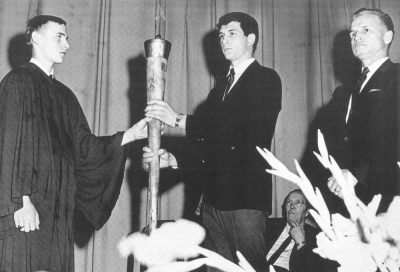
On March 22, 1968, the 60th and final commencement exercises for the Northwest School of Agriculture are held in Kiehle auditorium. Forty-two seniors receive their diplomas from Dr. B. E. Youngquist, superintendent of the Northwest School and Experiment Station. In the photo at right, the "Torch of Education" is passed from NWSA representative David Bohnsack to Ron Tobkin, Technical Institute student, as Director Stanley Sahlstrom (far right) looks on. This ceremony marks the passing of educational mission and duties to the new institution. Over its 63-year history, 5,433 graduates completed their high school education at the NWSA.
On Friday, June 7, 1968, commencement ceremonies are held for the first graduating class of the University of Minnesota Technical Institute. Seventy-two “tech” students earn associate degrees.
1968
The University of Minnesota Technical Institute is renamed the University of Minnesota Technical College.
1985
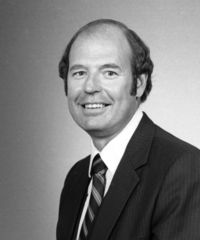
Donald G. Sargeant, Ph.D., is appointed provost of the Crookston campus on May 16, 1985. Sargeant first came to campus in 1970 as an assistant professor and worked his way from faculty to administration. The title for all coordinate campus chief executive officers is subsequently changed from provost to chancellor. Inauguration ceremonies for UMC's second leader are held on December 20, 1985.
1988
University of Minnesota Regents officially change the name of the Crookston campus to the University of Minnesota Crookston.
1992
At its June meeting the U of M Board of Regents gives UMC approval to offer baccalaureate degree programs.
1993
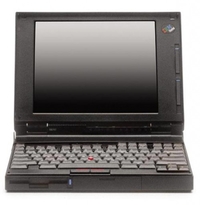
UMC's baccalaureate degree programs are approved by the Minnesota Higher Education Coordinating Board and accredited by the North Central Association of Colleges and Schools. Three academic divisions support a new polytechnic concept: Agricultural Management, Management, and Technical Studies. Classes for the baccalaureate degrees begin that fall.
UMC's technology component is initiated, providing each full-time student and faculty member with a notebook computer and preinstalled software--a first in the nation. UMC becomes known as the original “Laptop U.” Over the next few years, more than 100 colleges and universities visit the campus to learn more about this innovation. Some of these adopt programs modeled closely after UMC’s.
1994
UMC's first Bachelor of Science (B.S.) degrees are awarded at commencement ceremonies. A small group of students had been working on a "3 + 1" degree agreement before UMC had been authorized to offer four-year degrees. In the spring of 1994, twenty-four students receive their B.S. degrees at UMC. Below is a photo of the campus in 1994.
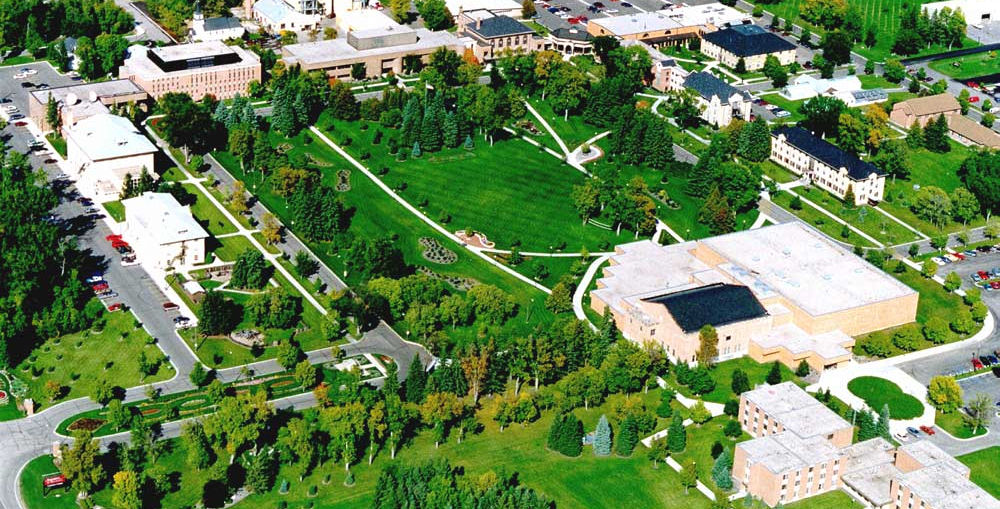
1995
On November 27, 1995, at the Teambackers Banquet, UMC announces that a new name had been chosen for its athletics teams: the Golden Eagles. The name change is meant to help signify UMC’s change in mission from a two-year college to a four-year university.
1998
UMC is ranked among the top four Best Midwest Regional Public Colleges by US News & World Report for the first time.
1999
UMC is accepted into the Northern Sun Intercollegiate Conference (NSIC) for Division II athletics. UMC is among three newly admitted members, which bring the NSIC to a conference of ten members.
2000
Yahoo! Internet Life Magazine Online ranks UMC the "#1 Most Wired College" in its category (Baccalaureate II) for 2000.
2001
UMC is honored with the Pioneer Award at the Fourth Annual Conference on Ubiquitous Computing, held January 4-6, 2001, at Seton Hall University in South Orange, New Jersey.
In its Monday, March 12, 2001, edition, The Wall Street Journal calls UMC "The College of the Future--Today" in a full-page feature appearing in a special section on technology and education.
At commencement ceremonies in May, the U of M, Crookston awards its first bachelor’s degree for a program completed entirely online. The Crookston campus is the first campus within the University of Minnesota system to offer degree programs fully online.
2003
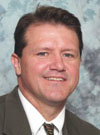
Velmer S. Burton, Jr., Ph.D., is named UMC's third chancellor. Inauguration is held on October 17, 2003.
2004
The Crookston campus receives approval from the Board of Regents of the University of Minnesota to offer new bachelor‘s degree programs in three areas: communication, computer software technology, and health sciences (pre-professional).
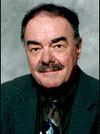
Joseph G. Massey, Ph.D., comes to the U of M, Crookston in July to serve as vice chancellor for academic affairs. He is appointed chief executive officer in November 2004, when Velmer Burton leaves.
Along with Charles Muscoplat, Ph.D., dean at the College of Agricultural, Food, & Environmental Science at the University of Minnesota, Twin Cities, Massey chairs the strategic positioning task force that will help shape the future of the U of M, Crookston.
2005

On September 12, 2005, Charles H. Casey, D.V.M., begins his appointment as chancellor at the University of Minnesota Crookston. Dr. Casey is a distinguished veterinarian and administrator with a strong rural background and an understanding of the challenges facing rural Minnesota.
The new Student Center, built on the site formerly occupied by Bede Hall, is dedicated in September followed by a campus and community picnic in front of the two-story, 37,550-square-foot building.
In late 2005, the U of M, Crookston formalizes an international partnership with Zhejiang Economic and Trade Polytechnic (ZETP) in Hangzhou, China, to enhance opportunities for students to study and faculty to work collaboratively.
2006
In February, the University of Minnesota Board of Regents approve UMC’s request to offer its existing Bachelor of Manufacturing Management (BMM) online, and in March, the Board approves UMC's request to offer is existing Bachelor of Science in Business online as well. This brings the number of UMC's online program offerings to three, including the Bachelor of Applied Health, which the campus had been offering online since 2000.
Agronomy and horticulture become two separate stand-alone bachelor‘s programs. The programs had previously been emphases within the plant industries management program.
The campus begins its centennial, a year-long celebration of 100 years of education, outreach, and service on the site of the campus, which began as the NWSA.
Centennial Hall is dedicated during the University of Minnesota Board of Regents meeting held on campus in October. The building compliments both the historical architecture of the campus and follows a nationwide trend to apartment-style campus living. With the completion of the new Centennial Hall complex, Lee Hall, an older campus apartment building, is demolished.
2007
The Crookston campus receives approval from the Board of Regents to offer new bachelor of science programs in two areas: Biology and Organizational Psychology. Equine Science and Animal Science become two separate stand-alone bachelor’s programs. The programs were previously emphases within the animal industries management program. The Board of Regents also approves a program option in Pre-Veterinary Medicine for the Equine and Animal Science Degree programs.
A growing reputation for excellence places the University of Minnesota Crookston in the top 161 “Best Midwestern Colleges” selected by The Princeton Review.
The U of M, Crookston earns its tenth consecutive appearance as U.S. News and World Report “Best College.”
Robertson Hall is demolished in the summer of 2007. The former residence hall, built in 1910, had also provided temporary office space during the renovation of Kiehle Building and the construction of the new Student Center.
2008
In February the U of M Crookston receives institutional approval from the Minnesota Board of Teaching to prepare students for state teacher licensure. In addition, the Board also approves delivery of early childhood education degrees by the Crookston campus. Designed to qualify students to be effective teachers of young children (birth through age 8) and to manage high-quality early childhood programs, licensure preparation was previously a cooperative endeavor.
In May, the Crookston campus receives approval from the Board of Regents to offer a new bachelor’s degree program in Criminal Justice beginning fall 2008 and, in September, the Board approves a request to offer its existing bachelor's degree program in Applied Students online starting January 2009.
The University of Minnesota Crookston hits record undergraduate enrollment with 1207 degree-seeking students.
A grant awarded to the U of M Crookston makes the campus a focal point statewide as the new Economic Development Administration (EDA) University Center for the state of Minnesota. The campus, along with its partner, University of Minnesota Extension, provides technical assistance and applied research for economic development intermediaries at the local, county, and regional levels throughout the state.
The Student Center, which opened in 2006, is officially named Sargeant Student Center in honor of Chancellor Emeritus Donald G. Sargeant, Ph.D. A ceremony held during homecoming marks the occasion.
To accommodate increasing enrollment, the campus gains approval from the Board of Regents to design and build a new apartment-style residence hall. The project involves a great deal of student input, especially with regard to issues of sustainability. Students lead the charge to seek Leadership in Energy and Environmental Design (LEED) certification. Groundbreaking ceremonies take place on October 15.
2009
Members of the one-hundred-and-first graduating class on the Crookston campus take part in commencement ceremonies held May 9. To acknowledge this new century mark, the newly-created Centennial Torch is passed from the outgoing to the incoming student body president.
The University of Minnesota Crookston marks a second year of record undergraduate enrollment with 1310 degree-seeking students for fall semester.
With the new on-campus apartment complex nearly complete, Brink Hall, an older campus apartment building, is demolished.
Otter Tail Power Company selects the U of M Crookston as its first collaborator in the Campus Energy Challenge. This first-of-its-kind program offers rebates and low-interest financing for energy-efficient technologies; encourages students, faculty, and staff to redirect behaviors to enhance energy conservation efforts; and provides in-depth energy education.
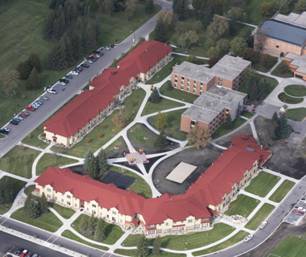
Evergreen Hall, the new 128-bed apartment-style residence hall, opens its doors to students as they arrive on campus for fall semester. The official building dedication takes place on Friday, October 2. U of M President Robert Bruininks is on hand for the ceremony. During the dedication, Otter Tail Power Company CEO Chuck MacFarland officially kicks off the Campus Energy Challenge.
The Crookston campus receives approval from the Board of Regents to offer new bachelor’s programs in two areas: marketing (B.S.) and quality management (B.M.M.). Both programs are also offered online.
2010
The Board of Regents approves a new bachelor’s degree program in environmental sciences (B.S.) and a name change for the computer software technology program to software engineering (B.S.). UMC's existing bachelor of science degree in accounting, offered on-campus, is also approved to be offered entirely online.
The University of Minnesota Crookston marks a third year of record undergraduate enrollment with 1462 degree-seeking students for fall semester. This represents a nearly 40% increase in degree-seeking students compared to the fall of 2006.
The Crookston campus receives a grant from the U.S. Dept. of Education to establish the Center for Rural Entrepreneurial Studies. Its mission is to provide leadership to advance entrepreneurship and to conduct applied research and engage faculty and students with regional entrepreneurs.
Federal stimulus funds help establish an immersive visualization and informatics lab at the U of M Crookston – one of only two in the Upper Midwest. The lab is leading-edge featuring technology that creates 3-D simulations with applications across many disciplines.
2011
The Higher Learning Commission approves the U of M Crookston’s request to move to the Academic Quality Improvement Program (AQIP) as the evaluation process for its accreditation. AQIP makes accreditation a continuous process with an emphasis on analytics and evidence-based decision making to help the campus improve quality and showcase effectiveness.
The New Century Learning Consortium admits the U of M Crookston as its 10th member. The Consortium assists universities in implementing high quality, large-scale online and blended learning programs and the sharing of best practices of e-learning.
Three additional degree programs offered on campus are approved by the Board of Regents to be offered online: communication, health management, and information technology management. This brings the total of online degrees offered to ten.
The University of Minnesota Crookston's online degree in business management is ranked among the "Top 10 Online Bachelor of Business Administration Degree Programs of 2011" by The Best Colleges, an online college search resource based in San Antonio, Texas.
Renovation of two 1950s-era science labs in Hill Hall transform them into team-based collaborative learning labs to support animal science, biology, organic chemistry, soil science, and water quality courses.
2012
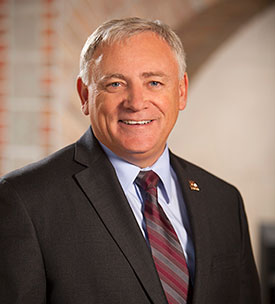
In January Chancellor Charles H. Casey announces his plans to retire on June 30, 2012. A national search takes place leading to the appointment of Fred E. Wood as chancellor. Wood, who holds a Ph.D. in inorganic chemistry, comes to the U of M from the University of California, Davis, where he had most recently served as vice chancellor of student affairs during his 26-year career there. Chancellor Wood takes the helm of the Crookston campus on July 2, 2012.
The Princeton Review and USA Today name UMC among their list of “Best Value Colleges: 2012 Edition.” Four Minnesota colleges make the list of 150: University of Minnesota Crookston; University of Minnesota Twin Cities; Carleton College; and Macalester College.
In February UMC is granted full-continuing approval from the Minnesota Board of Teaching to prepare individuals for Minnesota teacher licensure through June 30, 2019. The Board takes the action during their February meeting and also commends campus leaders for their expeditious response to the findings report and for evidencing full compliance to the required standards. With this approval, UMC is able to offer a major in elementary education, which had been approved by the Board of Regents the prior year.
Three new emphases are added to the bachelor’s degree program in communication: communication studies, organizational communication/public relations, and writing.
Construction begins in May for a new campus residence hall, located west of Centennial Hall. The 43,000 square foot, two story building accommodates 140 residents in 35 two-bedroom suites, with additional single rooms for four community assistants (CAs) and one community area coordinator staff member.
2013
At the beginning of spring semester in January, students move into the newest residence hall, Heritage Hall. The building accommodates a total of 144 students, primarily freshmen and sophomores, and includes a classroom named in honor of Harris Peterson, an NWSA alum who helped fund the classroom. Heritage Hall is officially dedicated on April 18, as part of inauguration ceremonies for Chancellor Wood.
Inauguration ceremonies for Fred E. Wood as the fifth chancellor of the University of Minnesota Crookston are held on Thursday, April 18. Guests include U of M President Eric Kaler; Regents Linda Cohen, Clyde Allen, Richard Beeson, Laura Brod, Thomas Devine, and Abdul Omari; as well as delegates from 17 other colleges and universities including Chancellors Jacqueline Johnson of the Morris campus and Stephen Lehmkuhle of the Rochester campus.
At the May meetings of the U of M Board of Regents, UMC is granted approval to offer a major in finance through the Business Department. The new bachelor’s degree program is offered both on campus and online and prepares graduates for employment in positions such as financial analysts, personal financial advisors, actuaries, and other positions in securities, commodities, and financial services.
At the October 2013 meeting of the U of M Board of Regents, approval is granted to offer UMC's current bachelor’s degree program in sport and recreation management online. Course offerings for the online major are set to begin spring semester 2014.
In December, the U of M Board of Regents approves the Business Department’s proposal for a new bachelor’s degree major in entrepreneurship, offered both on-campus and online effective spring semester 2014. Making use of existing courses and resources, the focus of the entrepreneurship major is on the recognition of business ideas and potential entrepreneurial ventures, as well as applied creativity, small business finance, and strategy development.
Approval is also granted in December for the Agriculture and Natural Resources Department to offer a new area of emphasis in ecological restoration within the current natural resources major. Graduates will be prepared to assess causes of land degradation and plan restorative actions.
2014
In early May commencement ceremonies for the Class of 2014 mark the largest graduating class in the history of the campus as well as the 20-year anniversary of the first baccalaureate degree graduates of the Crookston campus. U of M Crookston alumnus Tyler Grove, a member of the Class of 1994, is the guest speaker.
In May Minnesota Governor Mark Dayton signs the 2014 Legislative Bonding Bill, which includes state funding for several projects for the U of M system. One of these projects involves a $10 million allocation for a Wellness Center on the Crookston campus. An additional $5 million will be raised for the project through philanthropic and other efforts. A ceremonial groundbreaking for the new Wellness Center takes place on Monday, September 22, with an announcement of a $1 million gift for the project by Les and June Nielsen to name the lobby of the building in memory of their son, Mitch Lien Nielsen. Guests for the ceremony included U of M President Eric Kaler, Regents Clyde Allen and Thomas Devine, and several members of the Minnesota Legislature. Construction of the facility is anticipated to be completed by fall semester 2016.
In December, the U of M Board of Regents approves two additional majors for UMC: International Business and English as well as minors for both. The International Business major is designed to cultivate a global mindset that can support a company's international production and marketing needs and to broaden graduates' understanding of global business operations. A distinctive part of UMC's English major is the inclusion of literature from multicultural and global perspectives with the intention of developing and expanding the cultural awareness of graduates. The two new programs launch at the beginning of spring semester in January of 2015.
2015
At its February meeting, the U of M Board of Regents approves UMC’s Bachelor of Science Degree in Agricultural Education. With the major approved, the next step was a review and approval of teaching licensure for the program by the Minnesota State Board of Teaching, which was finalized and approved in October.
Site preparation and excavation for the new Wellness Center begin in May, with actual construction taking place in early June.
In June the Board of Regents approves two new academic majors: Exercise Science & Wellness and Medical Laboratory Science. Both culminate in a Bachelor of Science (B.S.) Degree and are administered through the Math, Science & Technology Department. The new majors are available to students beginning fall semester 2015 in August. The Medical Laboratory Science major is a collaborative program, and over the summer UMC works to finalize a consortium agreement and partnership with the University of North Dakota (UND) through the Western College Alliance of Medical Lab Science (WCAMLS). The UND medical laboratory science program is approved by the National Accrediting Agency for Clinical Laboratory Sciences (NAACLS).
2016
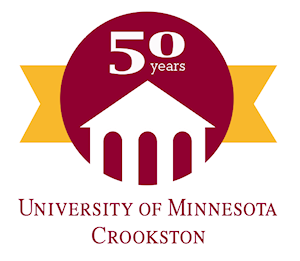
The University of Minnesota Crookston secures continued accreditation status from the Higher Learning Commission (HLC). At HLC’s February 8, 2016, meeting of its Institutional Actions Council, the organization officially took action to continue UMC’s accreditation with the next reaffirmation of accreditation in or before 2023-24. As part of the accreditation process, a team of peer evaluators trained in HLC’s standards visited the Crookston campus in November of 2015 and made recommendations to the HLC board. The Crookston campus is accredited separately at the institutional level from the University of Minnesota’s Twin Cities campus.
In July the newly constructed Wellness Center opens for student use. The 36,070 sq. ft. facility features a two-court gymnasium with suspended jogging/walking track, fitness/cardio areas, general locker rooms, a classroom, and a multipurpose room for group exercise—all to support the teaching and learning mission of the University and to foster student health, development, and success.
On September 21, 2016, the campus and community celebrate Founders Day with a special reception marking the 50th anniversary of higher education on the Crookston campus and the 20th anniversary of online degrees
2017

With the departure of Chancellor Fred Wood, who moved back to California to be closer to family, Barbara Keinath, vice chancellor for academic and student affairs, is appointed interim chancellor to lead the campus until a chancellor's search committee is formed and a new chancellor hired. Keinath, who was hired as vice chancellor in 2013, continues the work on enrollment, retention, and visioning. She serves in that capacity until June 30, when Mary Holz-Clause begins her tenure as chancellor.
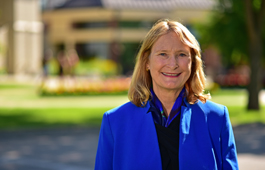
U of M President Eric Kaler appoints Holz-Clause, who comes to UMC from California State Polytechnic (Cal Poly) University Pomona, where she served as the dean of the Huntley College of Agriculture and as a tenured professor in the Department of Agricultural Business Management and Agriculture Science. Holz-Clause grew up in Iowa. After earning her B.S. in Agriculture Business, a Master in Public Administration, and a Ph.D. in Agriculture Education and Extension at Iowa State University, she spent 25 years working at her alma mater. During that time, she helped ISU Extension become a dynamic engagement and outreach partner across Iowa, the U.S. and the world. An internationally-known researcher and speaker, she also was appointed by California Governor Jerry Brown to serve on the California Department of Food and Agriculture Advisory Board, the primary advisory board for the $100 billion agriculture industry in California.
At its June 2017 meeting, the University of Minnesota Board of Regents grants approval to UMC to deliver both the existing on-campus Bachelor of Science (B.S.) degree and undergraduate minor in Agricultural Business online, effective fall 2018. The Board also approves UMC’s undergraduate honors program, which begins in fall semester 2017.
2018
At its February 2018 meeting, the University of Minnesota Board of Regents approves UMC’s new Bachelor of Science (B.S.) degree major in Agricultural Communication. The new major will be offered to students on-campus beginning fall semester 2018. The Board also grants approval to UMC to deliver both the existing on-campus Bachelor of Science (B.S.) degree and undergraduate minor in English online, also effective fall semester 2018.
Inauguration ceremonies for Mary Holz-Clause as the sixth chancellor of the University of Minnesota Crookston are held on Friday, April 6. Guests include U of M President Eric Kaler; Regents David McMillan, Kendall Powell, Thomas Anderson, and Michael Hsu; as well as delegates from 18 other colleges and universities including Chancellor Lendley Black of the Duluth campus, and new Chancellors Michelle Behr of the Morris campus and Lori Carrell of the Rochester campus.